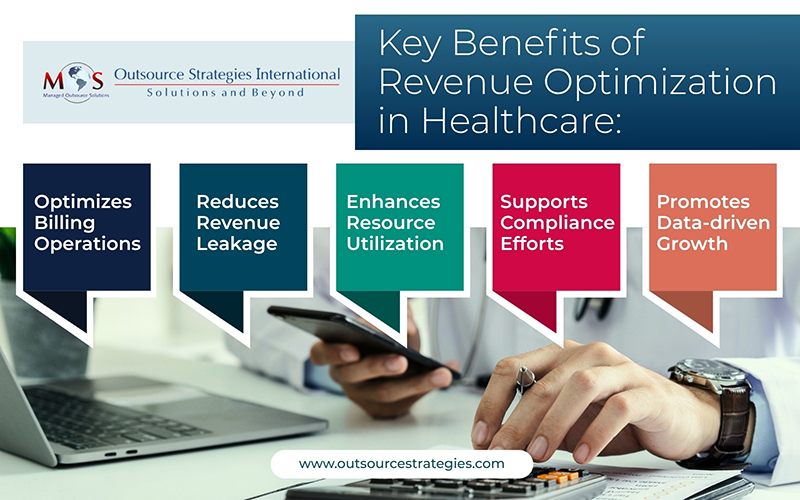The financial health of a medical practice directly influences its capacity to invest in the latest medical technology, provide ongoing staff training, and deliver optimal care. Modern patients expect personalized treatment, a smooth billing experience, and high-quality service from their healthcare providers. These initiatives often require upfront expenses, and medical organizations that focus on revenue optimization are better equipped to create a seamless patient experience.
Financial struggles, on the other hand, affect the practice’s ability to cover costs, leading to compromising care standards. If practices don’t have effective financial planning strategies in place, they may face issues such as inefficient staffing, reimbursement delays, and fluctuating patient volumes. These obstacles, if not managed effectively, not only impact patient care but also the long-term sustainability of healthcare organizations.
Healthcare revenue optimization is a targeted strategy that involves managing financial workflows to ensure all earned income is accurately billed, captured, and collected. Partnering with an experienced medical billing company is the ideal option to optimize RCM processes for maximum medical practice profitability.
What Is Revenue Optimization and How Is It Different from RCM?
In the context of the medical billing system, revenue optimization (RO) refers to the systematic management of every process within the financial cycle, starting from patient intake to final payment collection. While both revenue optimization and revenue cycle management (RCM) are closely related concepts of healthcare finance, RO presents a more focused and strategic approach within the broader framework of RCM. It emphasizes identifying and addressing inefficiencies, implementing best billing practices, and minimizing revenue leakage.
Healthcare providers that focus on RO can refine and enhance the overall performance of the billing cycle to maximize the practice’s profitability. The goal is not to merely collect payments, but to ensure that no legitimate reimbursement is lost due to outdated systems, missed opportunities, or administrative oversight. Through a series of continuous improvements such as increased coding accuracy, streamlined insurance verification, and reduced claim denials, practices can fine-tune their operations for better financial outcomes.

Why Revenue Optimization is Critical for Medical Practice Sustainability
Let’s go through the significant advantages of optimizing billing operations in healthcare with revenue optimization strategy:
- Optimizes Billing Operations
A financially healthy practice depends on predictable income to invest in necessary resources and maintain smooth operations. By automating the key components of the billing cycle, such as insurance verification, pre-authorization, and claims submission, practices can reduce manual workflow and boost employee productivity. Establishing clear billing protocols, improving the accuracy of charge capture, and increasing the rate of clean claims contribute to a more accurate reimbursement process. This not only decreases the rate of denials and appeals but also lessens the time taken to convert services rendered into actual payments. Over time, optimized billing processes reduce administrative burden and contribute to a more fiscally reliable healthcare facility.
- Reduces Revenue Leakage
Even well-run practices can lose substantial amounts of income due to small, overlooked errors. These mistakes may include incomplete patient data, incorrect coding, unpaid balances, or failure to follow up on denied claims. Over time, these errors accumulate and result in what is commonly referred to as “revenue leakage” in healthcare. Revenue optimization identifies these recurring problems and introduces corrective and preventive measures, ensuring that legitimate reimbursement is completely captured. By identifying areas of improvement, practices can fix inadequacies that lead to lost income and prevent redundant costs.
- Enhances Resource Utilization
A healthcare organization’s administrative and clinical teams are valuable assets. However, if they are frequently engaged in rework such as fixing billing mistakes or pursuing delayed payments, it reduces overall productivity. Revenue optimization introduces clearer processes, better training, and technology solutions that free staff from repetitive, low-value tasks, enabling them to focus on profit-generating efforts. Proper financial planning for healthcare providers results in efficient use of time and resources, both of which influence financial outcomes.
- Supports Compliance Efforts
Accurate documentation, coding and billing processes are not just income-producing initiatives, they are also legal requirements. Practices that lack strong internal controls risk facing audits, penalties, or reputational damage. Revenue optimization includes a focus on compliance, ensuring that all charges are properly documented and submitted in line with payer and regulatory expectations.
- Promotes Data-driven Growth
Revenue optimization allows practices to make financial decisions based on accurate data rather than assumptions. Whether a practice is considering expansion, new clinical service lines, or additional hiring, having a clear understanding of current financial performance and growth opportunities makes those decisions more informed and less risky. Healthcare facilities can track key performance metrics (KPIs) to gauge the efficacy of RCM activities. Without proper monitoring of the financial performance, practice development becomes speculative, which can strain resources or diminish the quality of care delivery.
Common Obstacles to Revenue Optimization
Despite its importance, many practices struggle to fully implement revenue optimization practices. Some of the common barriers include:
- Outdated systems: Practices that continue using legacy software or outdated systems that lack automation or integrated reporting may struggle with inefficient workflows and revenue leakage.
- Lack of trained personnel: Billing and coding processes require specialized knowledge of coding systems and billing guidelines. Inadequate staffing or training can lead to persistent errors.
- Fragmented workflows: When different departments or vendors handle parts of the revenue cycle independently, it often leads to growing inefficiencies and delays.
- Limited financial visibility: Without access to timely, actionable financial reports, it becomes challenging to identify areas of improvement, track cash flow, or take data-driven decisions.
Steps for Improving Billing Operations in Healthcare Practices
Medical facilities do not require a complete operational overhaul for achieving healthcare billing process improvement. Proactive, systematic steps can have a significant impact on a practice’s net income. A few practical strategies include:
- Audit common denial reasons: Conduct a review of recent denied claims to identify recurring and preventable issues.
- Evaluate coding accuracy: Verify that all services are accurately coded at the appropriate level and supported by concise and complete documentation.
- Train front-desk staff: Errors made during front desk operations frequently result in billing and reimbursement problems later.
- Track key financial indicators: Regularly monitor metrics such as days in A/R, first-pass claim resolution rate, and patient collection rates to assess and improve financial performance.
Fortify Your Practice’s Financial Strength with Outsourcing
Managing a practice is not only a clinical but financial responsibility as well. Outsourcing medical billing can serve as a financial growth strategy. Healthcare organizations navigating tight margins and rising administrative demands can selectively outsource finance-related functions such as billing, coding, and claims management processes. With the right partner, practices gain not only operational support but also sharper insights into revenue trends, faster reimbursements, and fewer denied claims. For organizations committed to both care and sustainability, revenue optimization is an essential function that safeguards their long-term financial health.
Want to ensure your practice stays financially robust?
Hire our medical billing experts for optimized operations and maximized cash flow!




